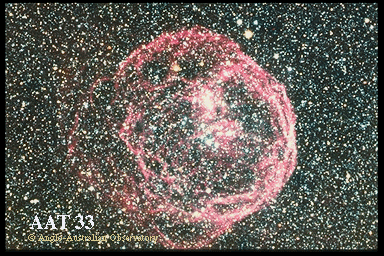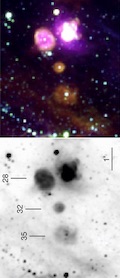The Stellar Content and Dynamics of Superbubbles in the
Large Magellanic Cloud
Marion Siang-li Oey
The University of Arizona, 1995
Advisor: Robert C. Kennicutt, Jr.

The superbubble N70 / DEM301 in the LMC.
The interaction between massive stars and the interstellar medium
(ISM) is a fundamental process determining the structure and
composition of the ISM. This work examines the stellar
content and resulting dynamics of
superbubbles in the Large Magellanic Cloud (LMC).
In work with P. Massey, I first show analytically that for 2 single-O
star bubbles in M33, the evolution of wind power as the
stars evolve is important in the bubble evolution. In a second prototype
study, we find that the LMC superbubble DEM 152 shows
evidence for sequential star formation, based on differing
ages between the stars interior and exterior to the shell.
We construct a numerical form of the standard
Weaver et al. (1977) evolutionary model for wind-driven bubbles, and
use the stellar census to compare the predicted shell evolution with
the observed kinematics. There is a substantial discrepancy:
the shell's observed expansion velocity is too large relative to its radius.
I then find that the color-magnitude diagrams of the associations within
7 LMC superbubbles and 5 classical H II regions
are indistinguishable. The H-R diagrams,
constructed with spectral types for 6 superbubble
clusters, also appear similar to those
in classical H II regions, implying that the shell
formation timescale is shorter than the cluster evolutionary
timescale. The stellar winds of the 1--2 most
massive stars must therefore dominate the shell formation.
The star-forming events for the superbubble associations are also no
more extended in duration than that of other OB associations.
The slopes of the initial mass functions appear normal.
Numerical modeling of the 6 superbubbles shows
results falling into two distinct categories: ``high-velocity'' objects
showing anomalous kinematics like DEM 152
and ``low-velocity'' objects which appear fairly consistent with the model.
X-ray evidence suggests that the high-velocity objects have been
accelerated by supernova remnant (SNR) impacts. Results
for both categories imply an overestimate in the growth rate
equivalent to an effective input power of up to an order of magnitude
too large.
| 








